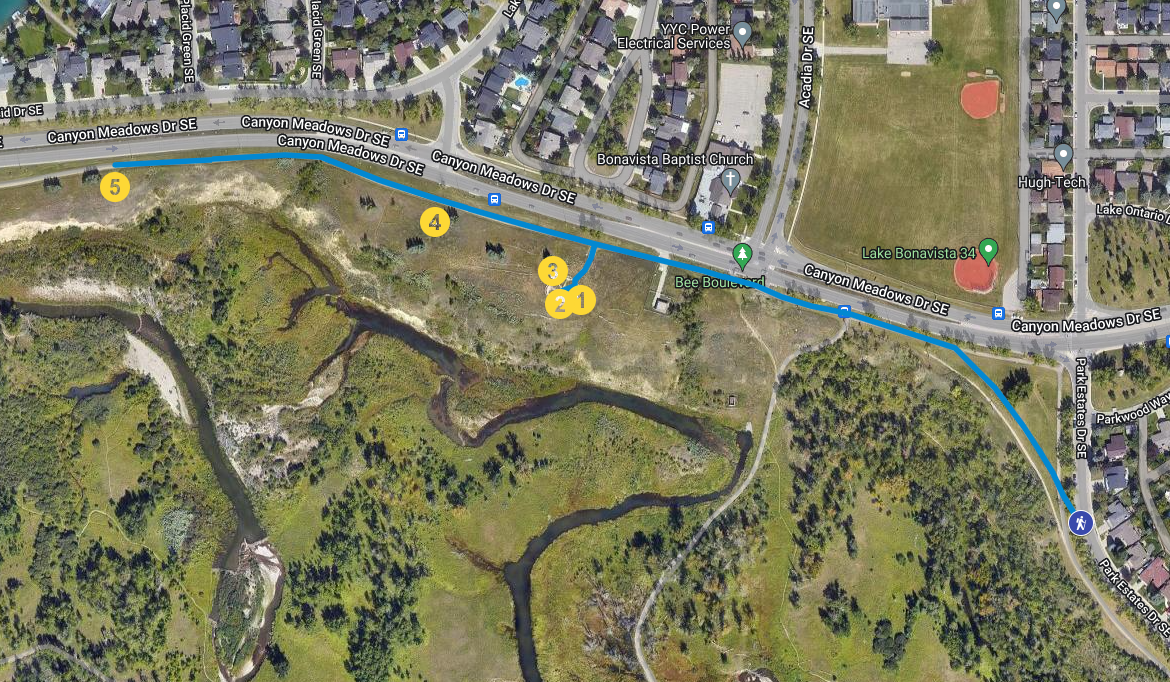Canyon Meadows Bee Boulevard self-guided walk
Total distance: Just under 1 km (one way)
Start location: Parks Estates Drive S.E., south of Canyon Meadows Drive S.E.
Please be respectful of other park users and follow Parks Bylaws:
- Stay on designated trails
- Do not litter
- Do not disturb or feed wildlife, including birds
- Dogs are permitted, but on leash only
- Pick up your dog's waste
- Do not collect plant or animal material
Enjoy your walk!
Stop 1: Main flower bed
To add value to the naturalization of City-owned parcels of land, the City partnered with researchers to investigate and document Calgary pollinators and their preferred vegetation types. Through a unique partnership between the City of Calgary, the University of Calgary, Mount Royal University, and the David Suzuki Foundation, this land corridor was transformed into an oasis for pollinators and an invaluable research site for local bee experts.
From above, the main flower beds before you take the shape of a large flower. Each ‘petal’ is edged with recycled sandstone. Before restoration, this flowerbed contained many non-native grass species and invasive plants. After removing this vegetation, a groundcover of Blue flax and Rocky Mountain fescue was planted, as were many native shrubs and wildflowers. To ensure resources for pollinators throughout the growing season, these flower beds contain plants that bloom from early spring, such as golden currant, gooseberry and alpine forget-me-not, to late-season bloomers such as goldenrod and sunflowers.
Thanks to the stewardship efforts of a local school, this area also contains over 600 showy milkweed plants, an important food source for butterflies. Taller plant species were placed closest to Canyon Meadows Drive to maximize floral encounters for pollinators and direct them upwards toward the median plantings.
Bee A Polli-neighbour: Plant native wildflowers in your garden this year to provide resources for pollinators.
Stop 2: Leafcutter bee display
Take a moment to explore the interactive solitary leafcutter bee display. Over 70% of native bees in Alberta are solitary! Solitary bees nest in tunnels, cavities, or the ground without hives or producing honey or wax — like bumblebees and honey bees do. Solitary bees come in all shapes and sizes and are often mistaken for other insects, such as flies and wasps. Solitary bees are not aggressive (many do not even have stingers) and are some of the most effective pollinators we have in our city.
Unlike solitary bees, bumblebees are known as ‘social bees’ and live in small colonies composed of a queen, worker bees and drones. All members of the bumblebee colony die off before the winter, and only the mated queens hibernate. Queens emerge in the spring and build nests to lay eggs. Bumblebees prefer to nest in piles of plant debris, tree cavities, and old rodent holes. Several nest boxes have been installed at this site to provide additional nesting habitat for native bumblebees.
Stop 3: Large bee hotel
Most of the infrastructure at this site is made from recycled materials. The pathways are made from recycled concrete, sandstone boulders were repurposed as planters, and native plants were brought in from another park that was being redesigned. The site also contains bee habitat enhancements, including bumblebee nest boxes, solitary bee hotels, nesting logs, and sand beds for ground-nesting bees.
Bee hotels are wooden nesting structures where solitary tunnel-nesting bees can lay their eggs. Females lay eggs in the late summer, and the eggs develop over the winter before hatching in the spring. The bee hotel in front of you is composed of logs removed from a golf course during a pathway realignment project. These logs were drilled with holes to function as homes for cavity-nesting bees, such as carpenter and mason bees. Most cavity-nesting bees in Alberta prefer to nest in holes ⅓’’ – ¼’’ in diameter.
Bee A Polli-neighbour: Consider adding bee hotels to your backyard this year!
Stop 4: Sandstone beds
Many of the plants in these sandstone flower beds were salvaged from another park undergoing construction. Look for species such as Yarrow, Gaillardia, Curly cup gumweed, and Northern bedstraw. The flower beds in this area are weeded once every year, and thatch is removed when required. Seed from the native plants grown here is collected for future plantings in other City parks.
These flower beds not only provide resources for pollinators throughout the growing season but also provide nesting habitat for native bees. While some solitary bees construct their nests in tunnels or cavities, many prefer to nest in the ground. The loose sand and soils in these sandstone planters provide excellent habitat for ground-nesting bees, such as mining and plasterer bees.
Stop 5: Additional bee habitat
In 2019, Calgary was named Canada’s 36th Bee City! This designation highlights the City’s commitment to providing habitat and resources for local pollinators. Projects such as the Canyon Meadows Bee Boulevard not only provide resources for native bees and insect pollinators but also provide excellent opportunities for pollinator-related research. Current research focuses on bee biodiversity and the floral preferences of bees in our parks and greenspaces. The results of this research help inform restoration work in our city and guide decision-making concerning which plants to use in different areas.
Recent research from the University of Calgary shows that our city has loads of native bees — with 199 species documented thus far. Calgary may contain more types of bumblebees than any other city in North America, three of which are endangered species! In 2018, two endangered gypsy cuckoo bumblebees were found at the Canyon Meadows Bee Boulevard.
Bee A Polli-neighbour: Consider contributing to ongoing bee research in our city and document the types of bees you find.



